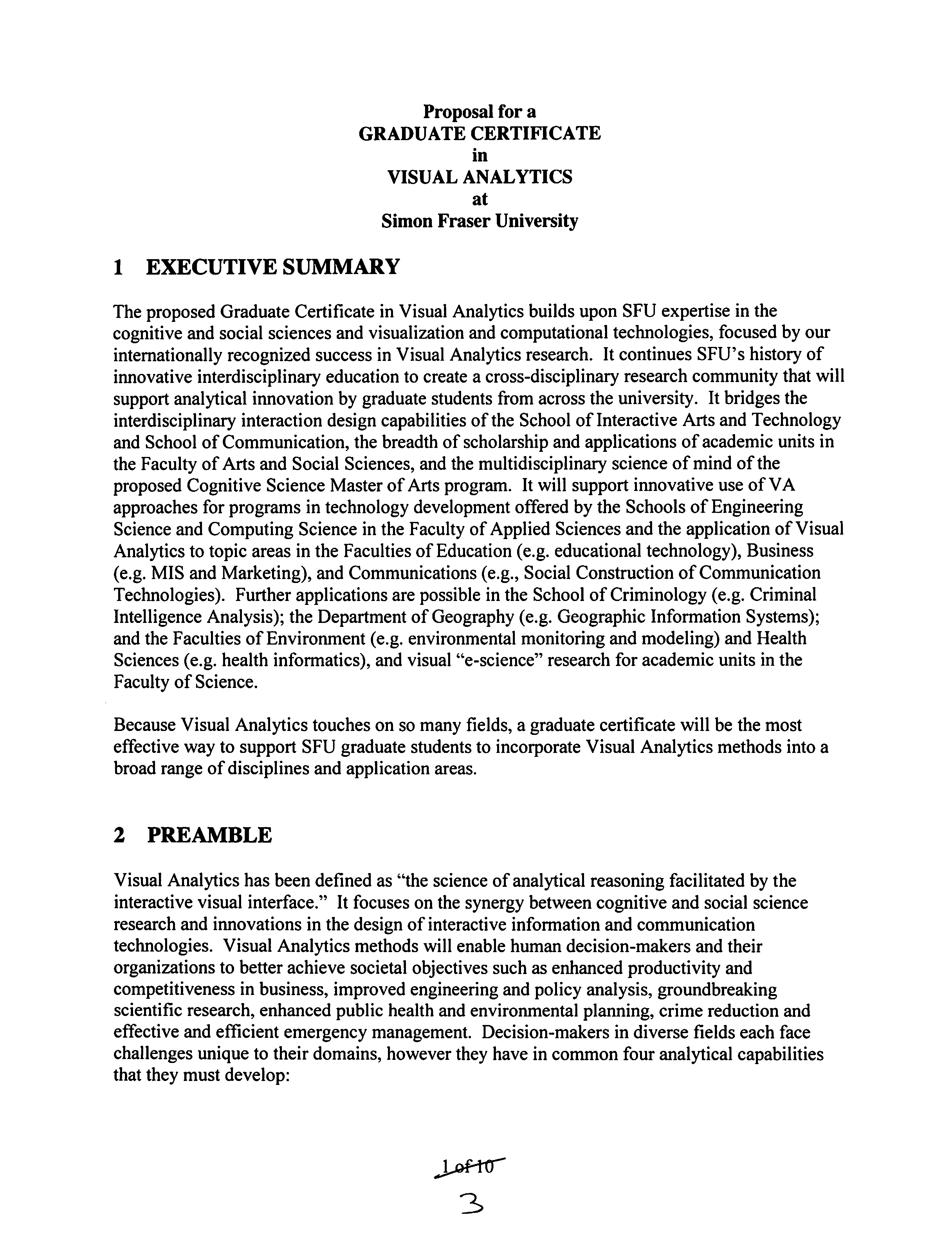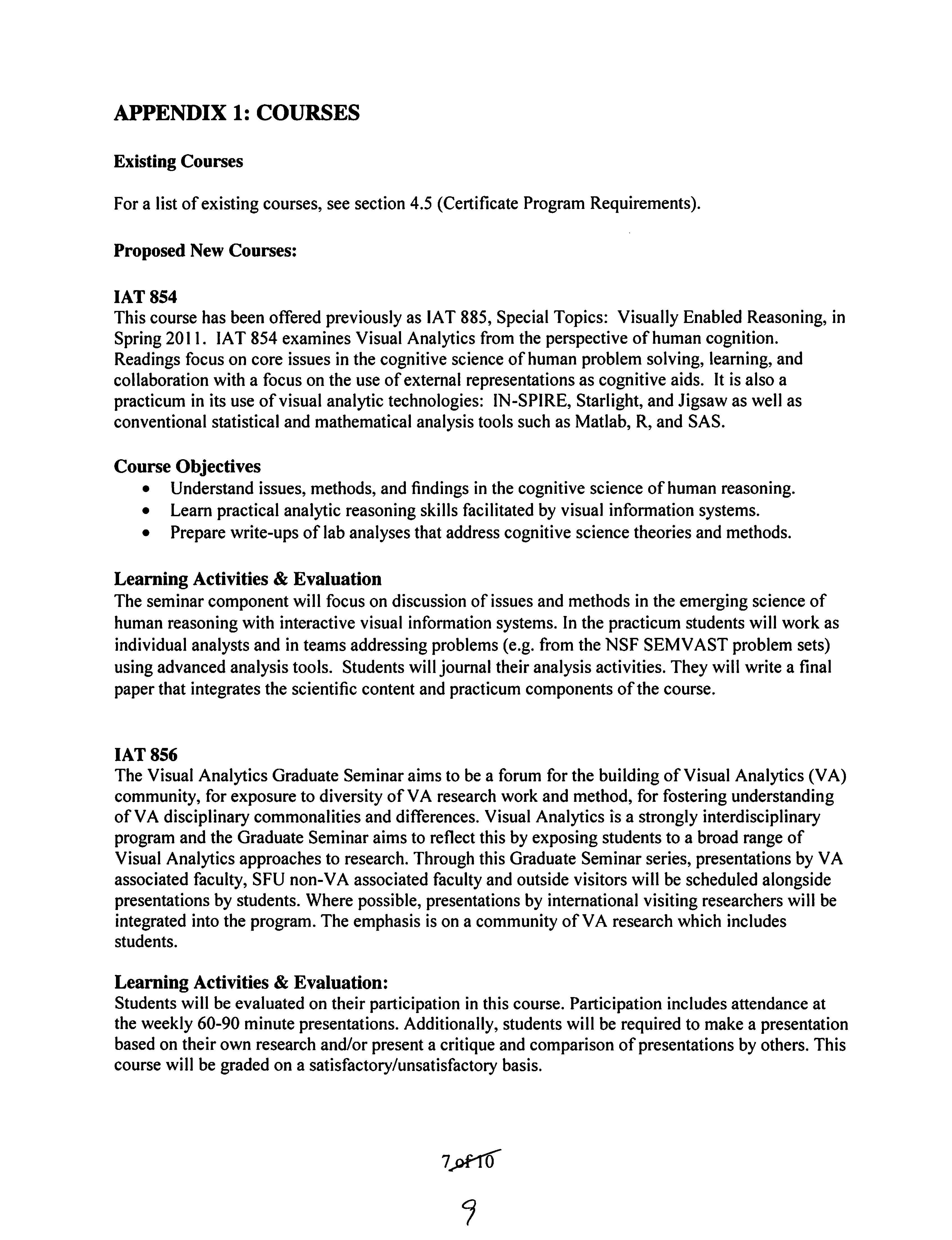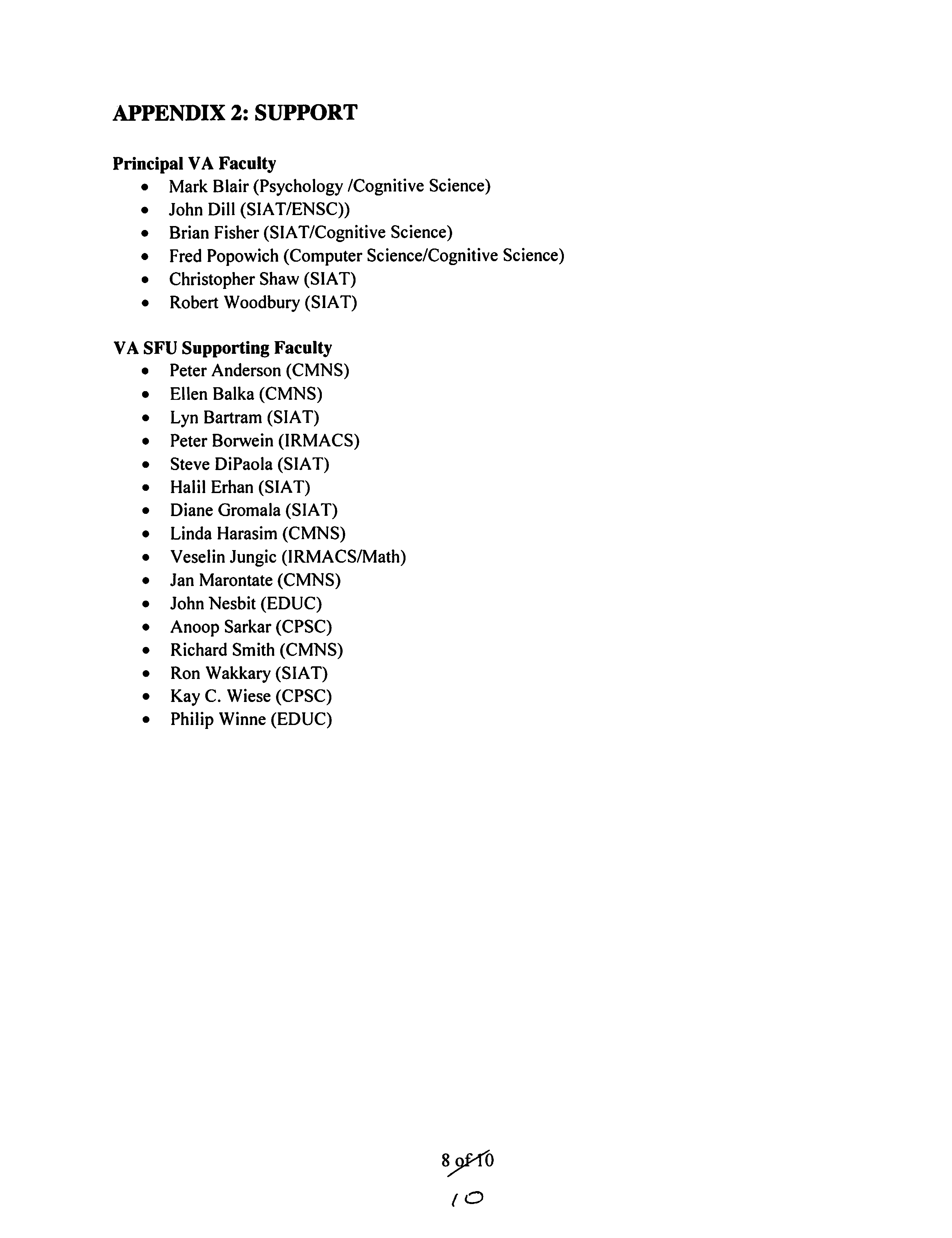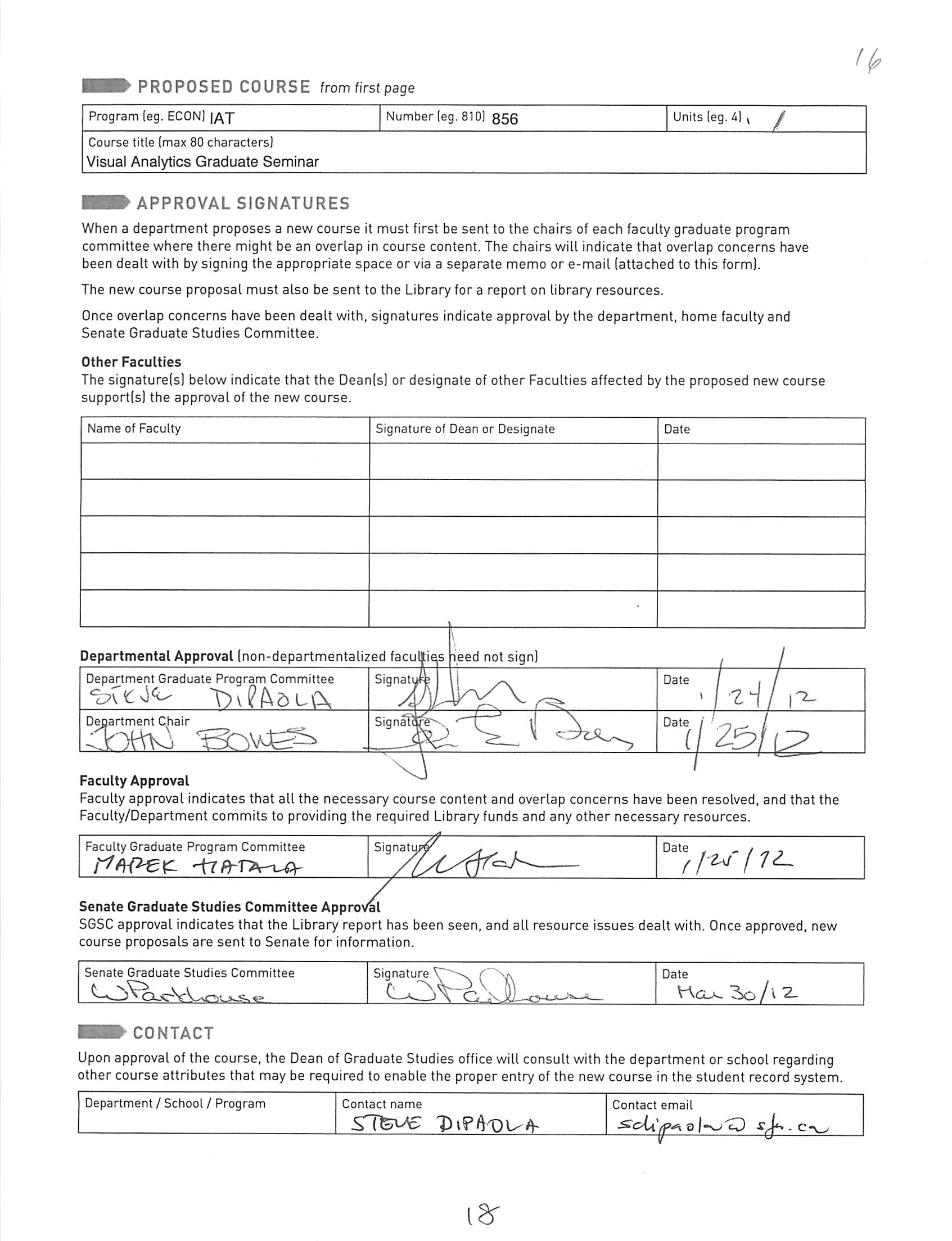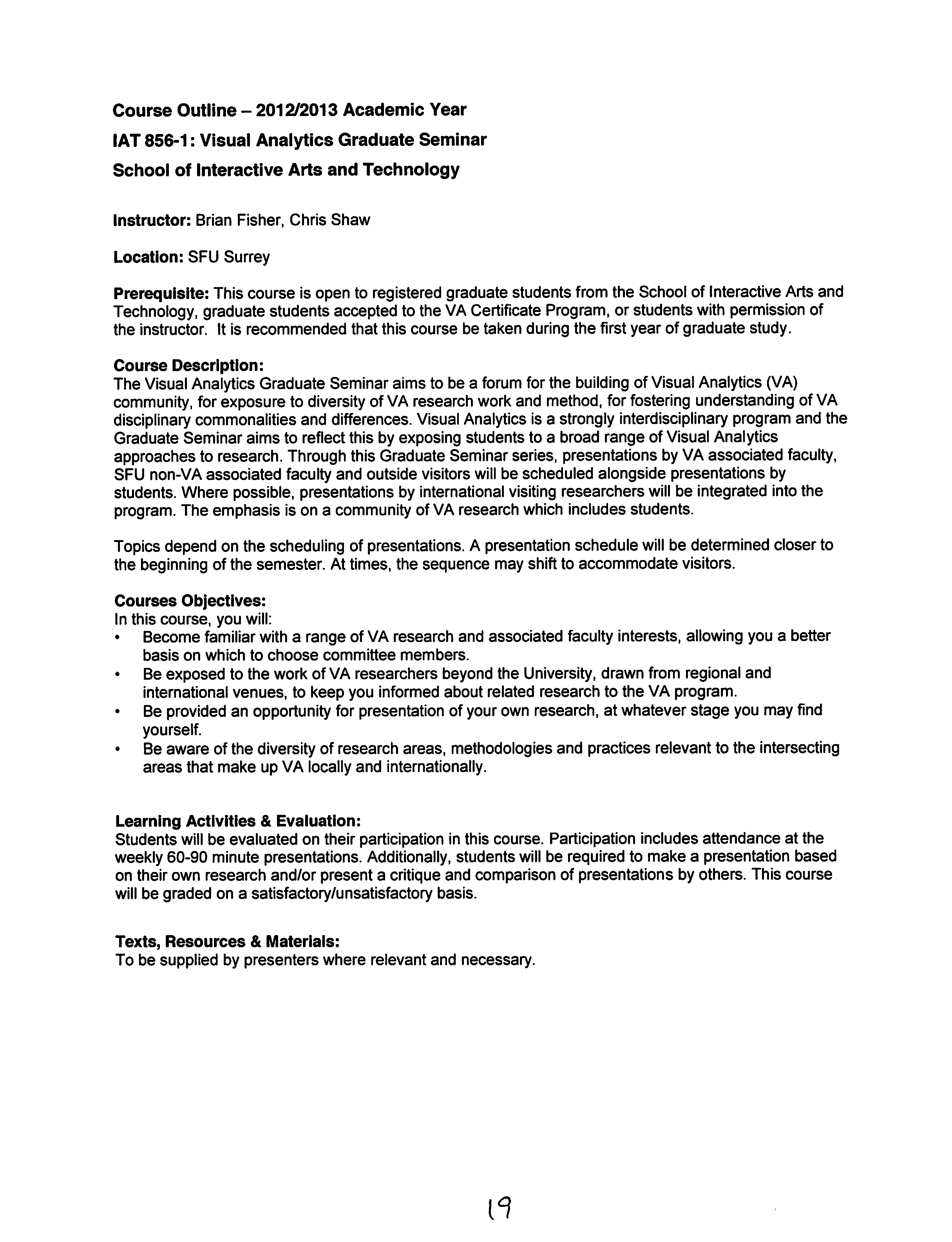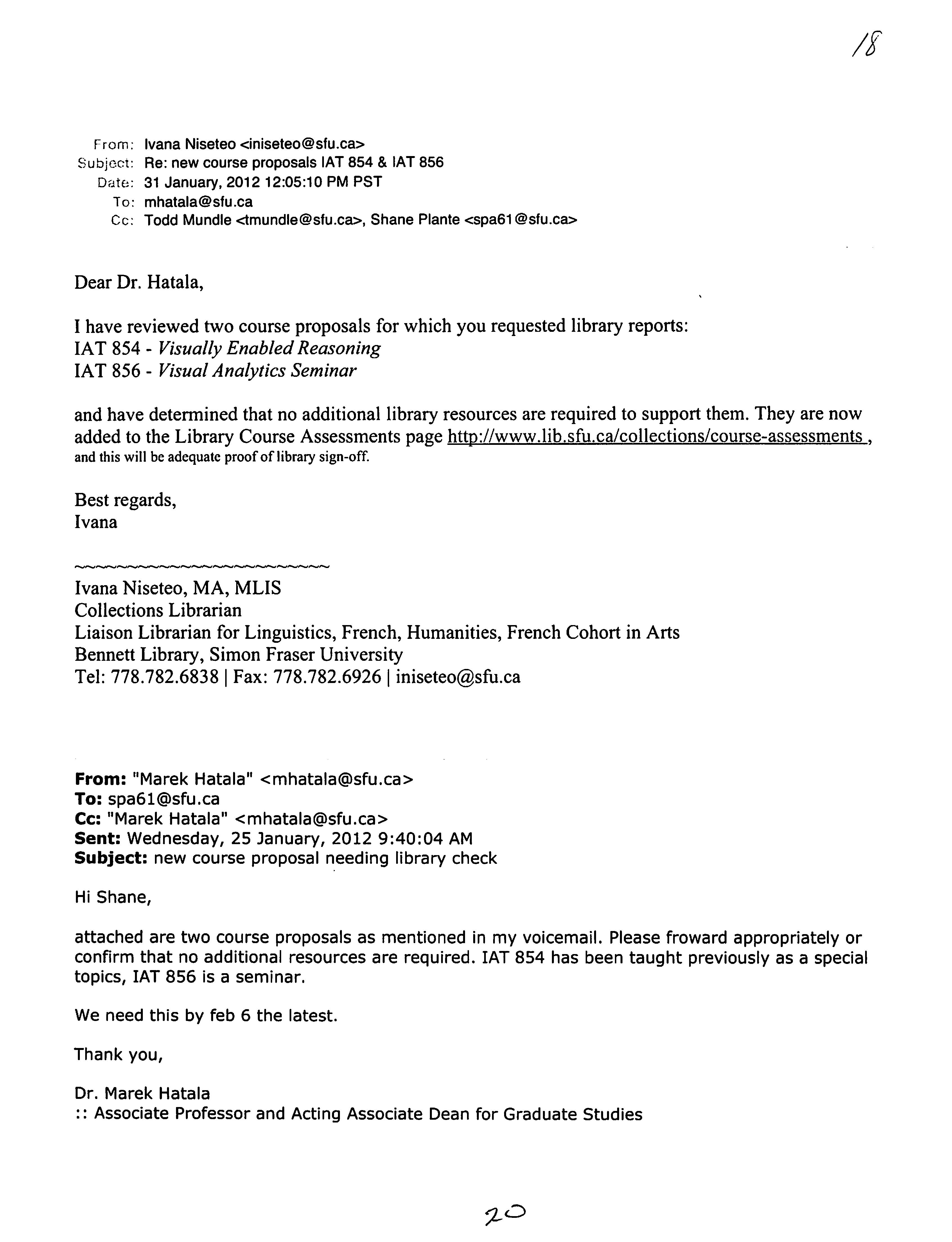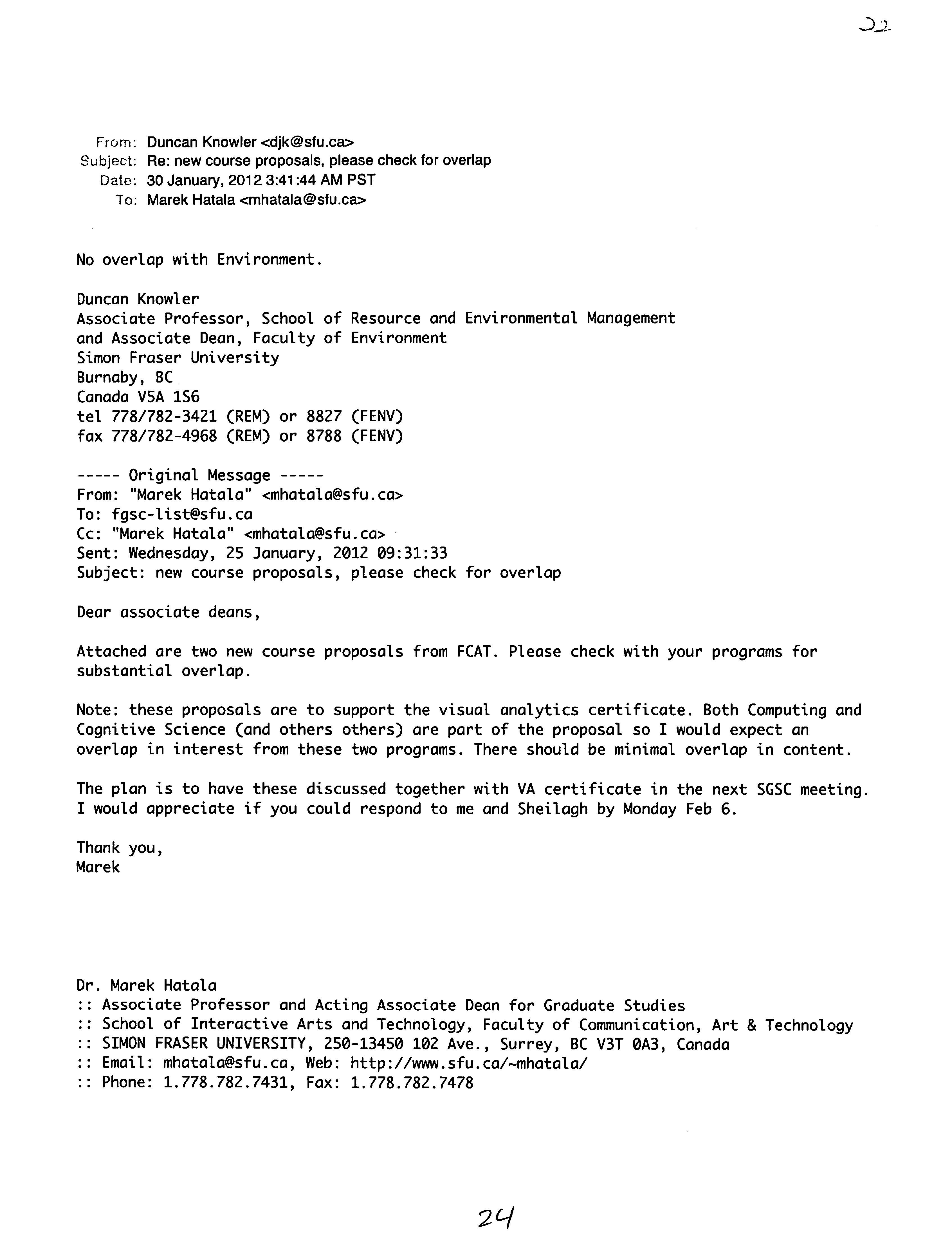S.12-74
SFU
OFFICE OF THE VICE-PRESIDENT, ACADEMIC AND PROV<
8888 University Drive, Bumaby, BC
Canada V5A 1S6
TEL: 778.782.3925
FAX: 778.782.5876
www.sfu.ca/vpacademic
MEMORANDUM
ATTENTION
FROM
RE:
Senate
date
May 1,2012
Jon Driver, Vice-President, Academic and
pages
1/1
Provost, and Chair, SCUP
Faculty of Communication, Art and Technology: Full Program Proposal for a Graduate
Certificate in Visual Analytics in the School of Interactive Arts and Technolpgy (SCUP 12-06)
At its April 11, 2012 meeting SCUP reviewed and approved the/Full Program Proposal for a Graduate
Certificate in Visual Analytics in the School of Interactive Arts apd Technology within the Faculty of
Communication, Art and Technology, effective Fall 2012.
Motion:
That Senate approve and recommend to the Board of Governors the Full Program Proposal for a Graduate
Certificate in Visual Analytics in the School of Interactive Arts and Technology within the Faculty of
Communication, Art and Technology, effective FaH 2012.- lSjOri/\«.
2oi'S>.
end.
c: S. DiPaolo
F. Popowich
SIMON FRASER UNIVERSITY
ENGAGING THE WORLD
MEMO
Dean of
Graduate Studies
SIR EiET ADDR l-.SS
Maggie Benston
Student Services Centre
1100
Burnaby BC V5A 1S6
Canada
MMI.INi; ADDRESS
8888 University Drive
Burnaby BC V5A 1S6
Canada
SFU
SCUP 12-06
TO:SCUP
TEL
FROM Wade Parkhouse, Dean, Graduate Studies
RE Visual Analytics Certificate
GS2012.09]
CC Marek Hatala
DATE March 28, 2012
At its meeting of 5 March, 2012, the SGSC approved the following proposal for a
Visual Analytics (VA) Certificate and is forwarding it to SCUP for consideration:
Faculty of Communication,
Art and
Technology
School of Interactive Arts and Technology (IAT)
Proposal for a Graduate Certificate in Visual Analytics
i) New course proposals:
IAT 854-3 Visually Enabled Reasoning
IAT 856-1 Visual Analytics Graduate Seminar
[GS2012.09]
Senators wishing to consult a more detailed report of curriculum revisions
may do so by going to Docushare:
https://docushare.sfu.ca/dsweb/View/Collection-12682
If you are unable to access the information, please call 778-782-3168 or email
shellev gair@sfu.ca.
7-
Proposal for a
GRADUATE CERTIFICATE
in
VISUAL ANALYTICS
at
Simon Fraser University
1 EXECUTIVE SUMMARY
The proposed Graduate Certificate in Visual Analytics builds upon SFU expertise in the
cognitive and social sciences and visualization and computational technologies, focused by our
internationally recognized success in Visual Analytics research. It continues SFU's history
of
innovative interdisciplinary education to create a cross-disciplinary research community that will
support analytical innovation by graduate students from across the university. It bridges the
interdisciplinary interaction design capabilities of the School of Interactive Arts and Technology
and School
of Communication, the breadth of scholarship and applications of academic units in
the Faculty of Arts and Social Sciences, and the multidisciplinary science of mind of the
proposed Cognitive Science Master of Arts program. It will support innovative use of VA
approaches for programs in technology development offered by the Schools of Engineering
Science and Computing Science in the Faculty of Applied Sciences and the application of Visual
Analytics to topic areas in the Faculties
of Education (e.g. educational technology), Business
(e.g. MIS and Marketing), and Communications (e.g., Social Construction
of Communication
Technologies). Further applications are possible in the School of Criminology (e.g. Criminal
Intelligence Analysis); the Department
of Geography (e.g. Geographic Information Systems);
and the Faculties of Environment (e.g. environmental monitoring and modeling) and Health
Sciences (e.g. health informatics), and visual "e-science" research for academic units in the
Faculty
of Science.
Because Visual Analytics touches on so many fields, a graduate certificate will be the most
effective way to support SFU graduate students to incorporate Visual Analytics methods into a
broad range of disciplines and application areas.
2 PREAMBLE
Visual Analytics has been defined as "the science of analytical reasoning facilitated by the
interactive visual interface." It focuses on the synergy between cognitive and social science
research and innovations in the design of interactive information and communication
technologies. Visual Analytics methods will enable human decision-makers and their
organizations to better achieve societal objectives such as enhanced productivity and
competitiveness in business, improved engineering and policy analysis, groundbreaking
scientific research, enhanced public health and environmental planning, crime reduction and
effective and efficient emergency management. Decision-makers in diverse fields each face
challenges unique to their domains, however they have in common four analytical capabilities
that they must develop:
3
• To evaluate, analyze, and understand patterns of information from masses of archival
and real-time data in a timely and effective manner.
• To manage increasingly complex and inter-related systems in business, engineering,
government, science, health, and the environment.
• To create, evaluate, and implement innovative solutions to familiar and emerging
problems.
• To operationalize their decisions within complex organizations and an increasingly
interconnected world with a diversity of cultures, sectors, and relationships.
Addressing these challenges will require the coordinated advancement of technological,
cognitive, and social systems. New computational algorithms and models must be developed in
step with the interactive visual interfaces that enable them to be effectively utilized by human
decision-makers. A new breed of technologically sophisticated analyst must adapt and apply
these new technologies in context
of their discipline, knowledge domain, organization, and
operational role. Organizations and even societies must evolve to better integrate new visual
information systems into business, government, and social processes.
The proposed Graduate Certificate in Visual Analytics builds upon SFU expertise in the
cognitive and social sciences and visualization and computational technologies, focused by our
internationally recognized success in Visual Analytics research. It continues
SFU's history of
innovative interdisciplinary education to create a cross-disciplinary research community that will
support analytical innovation by graduate students from across the university. It bridges the
interdisciplinary interaction design capabilities of the School of Interactive Arts and Technology
and School of Communication, the breadth of scholarship and applications of academic units in
the Faculty of Arts and Social Sciences, and the multidisciplinary science of mind of the
proposed Cognitive Science Master of Arts program. It will support innovative use of VA
approaches for programs in technology development offered by the Schools of Engineering
Science and Computing Science in the Faculty of Applied Sciences and the application of Visual
Analytics to topic areas in the Faculties
of Education (e.g. educational technology), Business
(e.g. MIS and Marketing), and Communications (e.g., Social Construction of Communication
Technologies). Further applications are possible in the School
of Criminology (e.g. Criminal
Intelligence Analysis); the Department
of Geography (e.g. Geographic Information Systems);
and the Faculties of Environment (e.g. environmental monitoring and modeling) and Health
Sciences (e.g. health informatics), and visual "e-science" research for academic units in the
Faculty of Science.
Because Visual Analytics touches on so many fields, a graduate certificate will be the most
effective way to support SFU graduate students to incorporate Visual Analytics methods into a
broad range of disciplines and application areas.
The proposed program will benefit from the focus on computational and mathematical analytics
of the Interdisciplinary Research in the Mathematical and Computational Sciences (IRMACS)
Centre's Modelling
of Complex Social Systems (MoCSSy) Graduate Certificate program. The
Visual Analytics Certificate program adds a pathway for students whose focus is on human
analytical processes as they are performed by individuals, organizations, and society as a whole.
2^fTD
y
These processes clearly incorporate models and modelling, and some MoCSSy courses may also
fulfill VA Certificate requirements.
3
PURPOSE OF GRADUATE CERTIFICATE
The Graduate Certificate will provide students an opportunity to learn within the framework of a
novel
interdisciplinary
program
that
will
enhance
their
achievement
and
encourage
collaborative
andintegrative approaches to research of national importance. Byproviding formal recognition
of the VA students' accomplishments, SFU will increase the students' academic potential and
mobility.
3.1 Innovative Scholarship with Real-World Applications
Visual Analytics is a new and growing field of study with substantial industry and government
interest and funding. A European Union 7th Framework Coordination Action ("VisMaster:
Mastering the Information Age"), a US NSF Program (Foundations of Data And Visual
Analytics") and a German Priority Program ("Scalable Visual Analytics") focus on Visual
Analytics. New programs are beginning in Asia and the Pacific. Students with interdisciplinary
training from the SFU VA certificate program will be in the position to apply for a greater
variety
of jobs, and have a stronger academic background to support them. Students will be
encouraged to publish in high quality journals, and to participate and present research results at
international conferences.
3.2 Enhanced employment opportunities for graduates
Leaders in industry and government increasingly recognize the role that Visual Analytics can
play in improving performance. Certificate students with an MA or MSc in an applied field can
be expected to have a strong competitive edge over other graduates in the job market. As part
of
the VA program, students are encouraged to work with industrial and government sponsors on
applications of VA. This provides students a chance to apply their skill sets, and build a better
understanding of the complexities of to real-world problems as well as contributing to innovative
scholarly research. The MITACS ACCELERATE BC program will be an important aspect of
this process, and they have agreed to coordinate with our program.
33 Increased Value to the Community
The focus on applications that meet societal needs will enable graduates of the VA program to
contribute to Canada in many ways. Their accomplishments will provide visible evidence of the
commitment of SFU to supporting the welfare of the community.
5~~
4 CERTIFICATE REQUIREMENTS
4.1 Participation in the VA Certificate
Graduate students may opt to participate in the VA certificate. All students intending to
participate are strongly encouraged to discuss theirintentions withtheirsupervisory committee
first. If appropriate, the supervisory committee may discuss the student'sintention with the VA
Managing Director and/or the VA Certificate Program Steering Committee prior to formally
communicating to the VA Program their intention to participate.
4.2 Enrolment, Support, and Tracking
Prospective students must apply to Simon Fraser University for admission and meet the normal
admission requirements for a graduate degree prior to undertaking the VA Graduate Certificate
Program. The VA Certificate program does not allow direct admission.
Certificate students must be enrolled and in good standing in a graduate degree program at SFU,
and must graduate in order to receive the Certificate. Qualified students should submit their
registration information to the VA Certificate Program Steering Committee as early as possible.
Upon registration they will be classified as a VA Certificate Student and placed on the mailing
list for announcements of VA events such as lectures and special courses. Our close relationship
with IRMACS will help to support our goal of presentation of seminars and course material
between SFU campuses.
The VA Certificate Program is intended for graduate students who will utilize Visual Analytics
methods for their thesis or other significant research projects. In order to better support students'
application of Visual Analytics methods VA Certificate students who do not already have an
affiliated faculty supervisor will be directed toward a VA affiliated faculty member who can
advise them on the use of Visual Analytics in their research. This faculty member may serve as
a co-advisor or active committee member.
The Visual Analytics Steering Committee will discuss with the Dean of Graduate Studies the
best process for tracking students in the Certificate using SIMS, and then implement that process.
Students accepted into the VA Certificate Program are encouraged to discuss sources of funding
and scholarships with the Program Director as well as with their supervisor.
43 Home Department Definition and Responsibilities
The department, school, or faculty to which a student is originally admitted shall be referred to as
the student's
home department.
The student'shome department is responsible for providing
standard student administrative support (photocopying, computer access, graduate secretary
access, etc.).
4.4 Program Structure
The graduate certificate combines the four key aspects of Visual Analytics: Cognition,
Technology, Society, and Integration. Integration is realized in a practical sense through
completion of a substantial research project using Visual Analytics methods, typically the
student's thesis work or another significant research project. This falls under the jurisdiction of
the student'sdepartment or school, and is thus outside of the scope of requirements for the VA
Certificate. Support for integration is provided by the VA Certificate program however, through
facilitating participation
of the certificate committee members on supervisory committees and
through the Visual Analytics seminar series.
The three area requirements are met by selecting four courses from the lists below, with at least
one course from each of the three content areas. Other courses that achieve the same goals, e.g.
special topics courses, can be proposed by departments or schools to the VA Certificate
Committee. Students may also petition for approval of a course by the committee. Upon
approval by the committee the course will be added to the list of approved courses in the
appropriate category. A maximum of two courses can be from the student's home department.
4.5 Certificate Program Requirements
Four courses are required in addition to the graduate seminar, IAT 856. The courses must be
chosen from at least two different Schools and must include at least one from each of the
following three lists of courses:
I.
Cognitive Processes—
Courses fulfilling this requirement must cover the cognitive
processes that underlie analytic practice, grounded in the practical application of VA
technologies to support human cognitive processes.
A. BUS 601-2 - Data and Decision-Making
B. EDUC 892-4 - Cognitive Tools and Multimedia Learning
C. IAT 854-3 - Visually Enabled Reasoning
D. IAT 812-3 - Cognition, Learning and Collaboration
II.
Visual Analytics Technology-
Courses fulfilling this requirement examine the creation,
selection, and customization of information systems in the student'sdiscipline or area of
interest. This includes data processing and modeling as well as interactive visualization.
A. BUS 709-3 - Managing Information
B.
CMPT 721-3 - Knowledge Representation and Reasoning
C. CMPT 767-3 - Visualization
D. IAT 814-3 - Knowledge Visualization & Communication
E. IAT 813-3 - Artificial Intelligence
III.
Social Systems—
Courses fulfilling this requirement examine the impact of advanced
visual analytic technology on individuals, organizations, and society in order to
determine how it can best be designed and introduced to support social and collaborative
processes.
5^pfft)
1
A. BUS 621-4 - Information Technology and Organizational Transformation
B. CMNS 815-5 - Social Construction of Communication Technologies
C. EDUC 893-4 - Organizational and Social Aspects of Learning Technology Design
4.6 VA Graduate Seminar Series and Workshops
A VA graduate seminar series, IAT 856-1, will provide an opportunity for students to discuss
relevant literature, to present their own research ideas, and to critique proposals for VA projects.
Students are expected to participate in this seminar each term, barring conflict with required courses
or RA/TA responsibilities. Topical VA workshops may be organized from time to time by the VA
Program. VA students are expected to participate in these VA events as their timetable permits. We
will work with IRMACS to enable presentation of events across SFU campuses.
5 PROCESS AND TIMELINES
Assuming approval every step of the way, the next steps in the process will be as follows:
• Discussions with potential host departments,./a//
2009
•
Review and approval by faculty graduate program committees,
spring 2011
•
Review and approval by Senate Graduate Studies Committee (SGSC),
spring 2012
•
Review and Approval by Senate,
summer 2012
•
First VA Certificate Program students admitted, ya//
2012
6>>ft0
8
APPENDIX 1: COURSES
Existing Courses
For a list of existing courses, see section 4.5 (Certificate Program Requirements).
Proposed New Courses:
IAT 854
This course has been offered previously as IAT 885, Special Topics: Visually Enabled Reasoning, in
Spring 2011. IAT 854 examines Visual Analytics from the perspective
of human cognition.
Readings focus on core issues in the cognitive science
of human problem solving, learning, and
collaboration with a focus on the use
of external representations as cognitive aids. It is also a
practicum in its use of visual analytic technologies: IN-SPIRE, Starlight, and Jigsaw as well as
conventional statistical and mathematical analysis tools such as Matlab, R, and SAS.
Course
Objectives
• Understand issues, methods, and findings in the cognitive science of human reasoning.
•
Learn practical analytic reasoning skills facilitated by visual information systems.
•
Prepare write-ups of lab analyses that address cognitive science theories and methods.
Learning Activities
&
Evaluation
The seminar component will focus on discussion of issues and methods in the emerging science of
human reasoning with interactive visual information systems. In the practicum students will work as
individual analysts and in teams addressing problems (e.g. from the NSF SEMVAST problem sets)
using advanced analysis tools. Students will journal their analysis activities. They will write a final
paper that integrates the scientific content and practicum components
of the course.
IAT 856
The Visual Analytics Graduate Seminar aims to be a forum for the building of Visual Analytics (VA)
community, for exposure to diversity of VA research work and method, for fostering understanding
of VA disciplinary commonalities and differences. Visual Analytics is a strongly interdisciplinary
program and the Graduate Seminar aims to reflect this by exposing students to a broad range
of
Visual Analytics approaches to research. Through this Graduate Seminar series, presentations by VA
associated faculty, SFU non-VA associated faculty and outside visitors will be scheduled alongside
presentations by students. Where possible, presentations by international visiting researchers will be
integrated into the program. The emphasis is on a community of VA research which includes
students.
Learning Activities & Evaluation:
Students will be evaluated on their participation in this course. Participation includes attendance at
the weekly 60-90 minute presentations. Additionally, students will be required to make a presentation
based on their own research and/or present a critique and comparison of presentations by others. This
course will be graded on a satisfactory/unsatisfactory basis.
7>>flTf
APPENDIX 2: SUPPORT
Principal VA Faculty
Mark Blair (Psychology /Cognitive Science)
John Dill (SIAT/ENSC))
Brian Fisher (SIAT/Cognitive Science)
Fred Popowich (Computer Science/Cognitive Science)
Christopher Shaw (SIAT)
Robert Woodbury (SIAT)
VA SFU Supporting Faculty
Peter Anderson (CMNS)
Ellen Balka (CMNS)
Lyn Bartram (SIAT)
Peter Borwein (IRMACS)
Steve DiPaola (SIAT)
Halil Erhan (SIAT)
Diane Gromala (SIAT)
Linda Harasim (CMNS)
Veselin Jungic (IRMACS/Math)
Jan Marontate (CMNS)
John Nesbit (EDUC)
Anoop Sarkar (CPSC)
Richard Smith (CMNS)
Ron Wakkary (SIAT)
Kay C. Wiese (CPSC)
Philip Winne (EDUC)
8^lt)
APPENDIX 3: MANAGEMENT FOR PROGRAM CHANGES AND
FUNDING
Certificate Steering Committee and Structure
The Certificate Steering Committee consists of the
• Three members elected by and from the VA Principal Investigators, covering the major
curriculum areas,
• A Chair elected by and from the VA Principal Investigators,and
• The VA Managing Director (ex-officio, advisory).
The term
of office for all non-advisory members of the Certificate Steering Committee is three years.
The Program Director is Chair of the Steering Committee.
Visual Analytics Principal Investigators
The VA Principal Investigators are
Mark Blair (Psychology, Cognitive Science)
John Dill (SIAT)
Brian Fisher (SIAT)
Fred Popowich (Computing Science, Cognitive Science)
Christopher Shaw (SIAT)
Robert Woodbury (SIAT)
The VA Principal Investigators are responsible for providing overall leadership and decision support
for the VA program. This includes developing overall research directions for the program, liaising
with University Deans and VPs to help promote the VA program at SFU, and selecting and hiring the
Program Director and Managing Director for the VA program. Any regular SFU faculty member
may apply and become a VA PI upon approval of the Certificate Committee.
The VA Program Director works closely with the VA Managing Director to ensure the day-to-day
running
of the VA program. This includes organizing VA symposiums, seeking new VA graduate
students, and maintaining a high level understanding of all VA sub-projects. The VA Program
Director is viewed as a short-term position; elected for a period of three years.
The initial VA Managing Director is Pamela Borghardt (IRMACS). The VA Managing Director
works closely with the VA Program Director to ensure the day-to-day running
of the VA program.
The VA Managing Director is viewed as a long-term position.
Program Changes
Additions and changes to the list of qualifying certificate courses will be made by the VA Certificate
Committee in consultation with the departments in which the courses are held. Graduate courses may
not be offered every year. Students who need to take required courses that are not offered in the
current year must contact the VA Program Director for suitable replacements.
Once the VA Certificate is established, it may become necessary or desirable to change the
I)
requirements. Changes in course lists for each department must be approved by the VA Certificate
Committee, the Graduate Chair of the affected department, and the Chair or Director of the affected
department or School. Changes in requirements regarding the VA Graduate seminar series must be
approved by the VA Certificate Committee. Bringing new departments into the VA Graduate
Certificate program must be approved by the Certificate Committee, and the Graduate Chair and
Chair or Director of the affected department or school, the appropriate Dean, and the Senate
Graduate Studies Committee.
I>cffl0
2_
SIMON FRASER UNIVERSITY
DEAN OF GRADUATE STUDIES
New Graduate Course Proposal Form
PROPOSED COURSE
Program leg. ECON] |AT
Course Title (max 80 characters)
Visually Enabled Reasoning
Number (eg. 810] 854
Short Title (appears on transcripts, max 25 characters]
Visually Enabled Reasoning
Units [eg. 4) 3
Course Description for SFU Calendar • see attached document • Learning outcomes identified
Explores how interactive visual interfaces can help to shape human cognitive processes. Itcombines the study of
visually-enabled reasoning as a cognitive science and the use of interactive visualization technologies such as IN-SPIRE,
Starlight,
and Jigsaw as well as conventional statistical and mathematical analysis tools that support human cognitive
processes.
Available Course Components: D Lecture El Seminar • Laboratory • Practicum • Online •
Grading Basis
El Graded
D Satisfactory/Unsatisfactory • In Progress/Complete
//
Prerequisites (if any]
• see attached document
Registered graduate students from the School of Interactive Arts and Technology, or with permission of the instructor.
• This proposed course is combined with an undergrad course: Course number and units:
Additional course requirements for graduate
students
D
See attached document (ifthis space is insufficient)
Campus at which course will be offered (check all that apply) D Burnaby 0 Vancouver ElSurrey • GNW •
Estimated enrolment
8-15
Date of initial offering
2012 Sept
Justification • See attached document
Course delivery (eg. 3 hrs/week for 13 weeks)
3 hrs/week for 13 weeks
This course both supports the proposed Visual Analytics Graduate Certificate Program as well as
strengthens current SIAT graduate offerings.
warn
RESOURCES
If additional resources are required to offer this course, the department proposing the course should be prepared to
provide information on the source(s) of those additional resources.
Faculty member(s) who will normally teach this course • information about their competency to teach the course is appended
Brian
Fisher, Chris Shaw, Bernhard Riecke
Number of additional faculty members required in order to offer this course
0
Additional space required in order to offer this course • see attached document
0
Additional specialized equipment required in order to offer this course Dsee attached document
0
Additional Library resources required (append details]
• Annually$.
0
13>
• One-time $_
PROPOSED COURSE
from first page
Program (eg. ECON] |AT
Course title (max 80 characters)
Visually Enabled Reasoning
Number (eg. 810] 854
Units(eg.
A)
3
M» APPROVAL SIGNATURES
When a department proposes a new course it must first be sent to the chairs ofeach faculty graduate program
committee where there might be an overlap in course content. The chairs will indicate that overlap concerns have
been dealt with bysigning the appropriate space or via a separate memo or e-mail (attached to this form).
The new course proposal must also be sent to the Library for a report on library resources.
Once overlap concerns have been dealt with, signatures indicate approval bythe department, home faculty and
Senate Graduate Studies Committee.
Other Faculties
The signature(s) below indicate that the Dean(s) or designate of other Faculties affected bythe proposed new course
support(s) the approval of the new course.
fr
Name of Faculty
Signature of Dean or Designate
Date
Departmental Approval
(non-departmentalized faculties neety hot sign)
Department Graduate Program Committee
Departmentjartment Chair
Lhair
d4j
<sa^*
Faculty Approval
Faculty approval indicates that all the necessary course content and overlap concerns have been resolved, and that the
Faculty/Department commits to providing the required Library funds and any other necessary resources.
Faculty Graduate Program Committee
Signatu
Date
±2d
Date
Date
/
l*rf-i*t
Senate Graduate Studies Committee Approval
SGSCapproval indicates that the Library report has been seen, and all resource issues dealt with. Once approved, new
course proposals are sent to Senate for information.
Senate Graduate Studies Committee
(_•<_• \ O—.ow*—o_4-»—e»—*
Date
••^CONTACT
Upon approval of the course, the Dean of Graduate Studies office will consult with the department or school regarding
other course attributes that may be required to enable the proper entry of the new course in the student record system.
Department / School / Program
5~
( PrT
Contact name
Contact email
—
.
w
NOTE:
These outlines are drafts and are subject to change.
Course Outline - 2012/2013 Academic Year
IAT 854-3: Visually Enabled Reasoning
School of Interactive Arts and Technology
Instructor:
Brian Fisher, Chris Shaw, Bernhard Rieck
Location:
SFU Surrey
Prerequisite:
This course is open to registered graduate students from the School of Interactive Arts and
Technology, or with permission of the instructor. The course assumes a moderate level of technical skill
(use of computers, spreadsheets etc.) and the ability to read and understand scientific and technical
papers
Course Description:
Interactive visual information systems are increasingly used to support human analysis and decision
making. Areas as diverse as engineering, health, finance and policy making can benefit from a "science
of analytical reasoning facilitated by the interactive visual interface". The use of these in analysis call for
new standards for evidence, criteria for proof, and methods for building agreement about policies, plans
and methods by which they can be implemented. An analytics of the visual image will include aspects of
cognitive, perceptual
and social sciences, computational and mathematical approaches to implementation
of analytic technologies to
support human cognitive processes, and a new body of design knowledge.
This course explores how interactive visual interfaces can help to shape human cognitive processes. It
combines the study of visually-enabled reasoning as a cognitive science and the use of interactive
visualization technologies
such as IN-SPIRE, Starlight, and Jigsaw as well as conventional statistical and
mathematical analysis tools that support human cognitive processes. The course is intended to build
common ground for collaboration on visual analytics for students in a range of disciplines. Students will
present and discuss original research methods and findings from the literature (e.g. the IEEE Conference
on Visual Analytics Science and Technology) and from their own work. The expectation is that students
will engage in critical discussion of concepts and approaches that are utilized in visual analytics and
related research areas
Courses Objectives:
• Understand core research issues, methodologies, and findings in the cognitive science of human
analytic processes
• Learn practical analytic reasoning skills facilitated by visual analytic information systems
• Prepare focused write-ups of analytic processes that integrate and advance cognitive science
theories and methods
Learning Activities & Evaluation:
The seminar component will focus on discussion of issues and methods in the emerging science of
human reasoning with interactive visual information systems. In
the practicum students will work as
individual analysts and in teams addressing analytic problems (e.g. from SEMVAST) using advanced
visual analysis tools. Students will journal their analysis activities. They will write a final paper that
integrates the seminar and practicum components of the course
Evaluation:
50% final paper, 25% journal, 25% participation
-r
Texts, Resources & Materials:
REQUIRED:
• Structured Analytic Techniques for Intelligence Analysis by Richards J. Heuer, Randolph H. Pherson
and John McLaughlin
• Causal Models: How People Think about the World and Its Alternatives. S. Sloman, Oxford Press
RECOMMENDED:
Human Reasoning and Cognitive Science. Keith Stenning &Michiel van Lambalgen, MIT Press
How We Reason. Philip Johnson-Laird, Oxford Press
ONLINE:
Illuminatingthe Path, a R&D Agenda for Visual Analytics J. Thomas and K. Cook
Psychology of Intelligence Analysis. R. J. Heuer, CIA
Analytic Pathologies, J. Cooper
SELECTED READINGS:
Information Foraging Theory: Adaptive Interaction with Information. P. L. T. Pirolli, Oxford Press
• Tools for Innovation. Arthur B. Markman and Kristin L. Wood, Oxford Press
Thinking With Data. Marsha C. Lovett and Priti Shah (Editors), Lawrence Erlbaum
Schedule
1. Intro to Va
2. Logic and problem solving
3. Text analysis 1 (INSPIRE)
4.
Text analysis 2
5. Quant analysis (Tableau)
6.
Quantanalysis 2
7.
Link analysis
8. Geographic analysis (Geotime)
9. Mixed—initiative systems
lb
SIMON FRASER UNIVERSITY
DEAN OF GRADUATE STUDIES
New Graduate Course Proposal Form
PROPOSED COURSE
Program (eg. ECON) |AT
Course Title (max 80 characters)
Visual Analytics Graduate Seminar
Number (eg. 810) 856
Short Title (appears on transcripts, max 25 characters)
Visual Analytics Seminar
,/£
Units (eg.
A)
J-
Course Description for SFU Calendar
O
see attached document • Learning outcomes identified
.
Aims to be a presentation forum for the building of Visual Analytics (VA) community, for exposure to
diversity of VA research work and method, for fostering understanding of VAdisciplinary
commonalities and differences.
Available Course Components: D Lecture EI Seminar • Laboratory • Practicum • Online •
Grading Basis EI Graded/' El Satisfactory/Unsatisfactory • In Progress/Complete
Prerequisites (ifany] • see attached document
Registered graduate students from the School of Interactive Arts and Technology, or with permission of the instructor.
• This proposed course is combined with an undergrad course: Course number and units:
Additional course requirements for graduate students • See attached document (ifthis space is insufficient)
Campus at which course will be offered (check all that apply) O Burnaby E)Vancouver El Surrey • GNW •.
Estimated enrolment
8-15
Date of initial offering
Sept 2012
Course delivery (eg. 3 hrs/week for 13 weeks)
3 hrs/week for 13 weeks
Justification • See attached document
This course both supports the proposed Visual Analytics Graduate Certificate Program as well as
strengthens current SIAT graduate offerings.
••t RESOURCES
Ifadditional resources are required to offer this course, the department proposing the course should be prepared to
provide information on the source(s) of
those additional resources.
Faculty member(s) who will normally teach this course • information about their competency to teach the course is appended
Brian Fisher, Chris Shaw
Number of additional faculty members required in order to offer this course
0
Additional space required in order to offer this course • see attached document
0
Additional specialized equipment required in order to offer this course Dsee attached document
0
Additional Library resources required (append details)
• Annually$.
0
n
• One-time $.
'*
•••PROPOSED
COURSE
from first
page
Program (eg. ECON) |AT
Number(eg. 810) 856
Units (eg. 4)
K
/
Course title (max 80 characters)
Visual Analytics Graduate Seminar
Wam
APPROVAL SIGNATURES
When a department proposes a new course it must first be sent to the chairs of each faculty graduate program
committee where there might be an overlap in course content. The chairs will indicate that overlap concerns have
been dealt with bysigning the
appropriate space or via a separate memo or e-mail (attached to this form).
The new course proposal must also be sent to the Library for a report on library resources.
Once overlap concerns have been dealt with, signatures indicate approval by the department, home faculty and
Senate Graduate Studies Committee.
Other Faculties
The signature(s) below indicate that the Dean(s) or designate of other Faculties affected bythe proposed new course
support(s) the approval of the new course.
Name of Faculty
Signature of Dean or Designate
Departmental Approval
(non-departmentalized faculties
Department Graduate Program Committee
tjj; M^
t?V
Department Lhair
Faculty Approval
Faculty approval indicates that all the necessary course content and overlap concerns have been resolved, and that the
Faculty/Department commits to providing the required Library funds and any other necessary resources.
Faculty Graduate Program Committee
Senate Graduate Studies Committee Approval
SGSC approval indicates that the Library report has been seen, and all resource issues dealt with. Once approved, new
course proposals are sent to Senate for information.
Date
Date
<v\
z*^
Date
/
m ip
Date
(Mil*-
Senate Graduate Studies Committee
Signature V~^s
(
"*\\
Date
Hdx3o/i2.
••* CONTACT
Upon approval of the course, the Dean of Graduate Studies office will consult with the department or school regarding
other course attributes that may be required to enable the proper entry of the new course in the student record system.
Department / School / Program
Contact name
S7£M> T>lPrV0Ufr
18-
Contact email
''CAX/P^i
o |-j"Q -cJ*> • c-
Course Outline - 2012/2013 Academic Year
IAT 856-1: Visual Analytics Graduate Seminar
School of Interactive Arts and Technology
Instructor:
Brian Fisher, Chris Shaw
Location:
SFU Surrey
Prerequisite:
This course is open to registered graduate students from the School of Interactive Arts and
Technology, graduate students accepted to the
VA Certificate Program, or students with permission of
the instructor. It is recommended that this course be taken during the first year of graduate study.
Course Description:
The Visual Analytics Graduate Seminar aims to be a forum for the building of Visual Analytics (VA)
community, for exposure to diversity of VA research work and method, for fostering understanding of VA
disciplinary commonalities and differences. Visual Analytics is a strongly interdisciplinary program and the
Graduate Seminar aims to reflect this by exposing students to a broad range of Visual Analytics
approaches to research. Through this Graduate Seminar series, presentations by VA associated faculty,
SFU non-VAassociated faculty and outside visitors will be scheduled alongside presentations by
students. Where possible, presentations by international visiting researchers
will be integrated into the
program. The emphasis is on a community of VA research which includes students.
Topics depend on the scheduling of presentations. A presentation schedule will be determined closer to
the beginning of the semester. Attimes, the sequence may shift to accommodate visitors.
Courses
Objectives:
In this course, you will:
Become familiar with a range of VAresearch and associated faculty interests, allowing you a better
basis on which to choose committee members.
Be exposed to the work of VAresearchers beyond the University, drawn from regional and
international venues, to keep you informed about related research to the VA program.
Be provided an opportunity for presentation of your own research, at whatever stage you may find
yourself.
Be aware of the diversity of research areas, methodologies and practices relevant to the intersecting
areas that make up VA locally and internationally.
Learning Activities
&
Evaluation:
Students will be evaluated on their participation in this course. Participation includes attendance at the
weekly 60-90 minute presentations. Additionally, students will be required to make a presentation based
on their own research and/or present a critique and comparison of presentations by others. This course
will be graded on a satisfactory/unsatisfactory basis.
Texts, Resources
&
Materials:
To be supplied by presenters where relevant and necessary.
H
From: Ivana Niseteo <iniseteo@sfu.ca>
Subject: Re: new course proposals IAT 854 &IAT856
Date: 31 January, 2012 12:05:10 PM PST
To: mhatala@stu.ca
Cc: Todd Mundle <tmundle@sfu.ca>, Shane Plante <spa61 @sfu.ca>
//
Dear Dr. Hatala,
I have reviewed two course proposals for which you requested library reports:
IAT 854 -
Visually Enabled Reasoning
IAT 856 -
Visual Analytics Seminar
and have determined that no additional library resources are required to support them. They are now
added to the Library Course Assessments page http://www.lib.sfu.ca/collections/course-assessments .
and this will be adequate proof of library sign-off.
Best regards,
Ivana
Ivana Niseteo, MA, MLIS
Collections Librarian
Liaison Librarian for Linguistics, French, Humanities, French Cohort in Arts
Bennett Library, Simon Fraser University
Tel: 778.782.6838 | Fax: 778.782.6926 | iniseteo@sfu.ca
From:
"Marek Hatala" <mhatala@sfu.ca>
To: spa61@sfu.ca
Cc: "Marek Hatala" <mhatala@sfu.ca>
Sent:
Wednesday, 25 January, 2012 9:40:04 AM
Subject:
new course proposal needing library check
Hi Shane,
attached are two course proposals as mentioned in my voicemail. Please froward appropriately or
confirm that no additional resources are required. IAT 854 has been taught previously as a special
topics, IAT 856 is a seminar.
We need this by feb 6 the latest.
Thank you,
Dr. Marek Hatala
:: Associate Professor and Acting Associate Dean for Graduate Studies
%<=>
2/22/12
SFU Connect
, y
SFU Connect
sheilagh@sfu.ca
Re: IAT 854 and 856
From
: Marek Hatala <mhatala@sfu.ca>
Wed, Feb 22, 2012 09:14 AM
Subject:
Re: IAT 854 and 856
J>6 attachments
To
: Sheilagh MacDonald <sheilagh@sfu.ca>
Cc
: Marek Hatala <mhatala@sfu.ca>
Hi,
I have handed those to you lasttime in hard copy. The emails are attached. These are all
I received. Wade last
time said: "no response, no conflict".
Here are the two course forms. I changed the prerequisites to include the visual analytics.
IAT856 form has also a change against the last version - unchecked "Graded".
Marek
On 2012-02-20, at 4:45 PM, Sheilagh MacDonald wrote:
Hi Marek,
Just a reminder that SGSC will need a library report and your email to fgsc-
list requesting that your
fellow Associate Deans review your new courses and
indicate if they have overlap concerns. We'll need copies of any responses as
well.
Sheilagh
From:
"Marek Hatala" <mhatala@sfu.ca>
nttps://connect.sfu.ca/zimbra/h/printmessage?id=160305
^
\
<*/3f
2/22/12
SFU Connect
To: "Sheilagh MacDonald" <sheilaah(5)sfu.ca>
^
Cc: "Marek Hatala" <mhatala@sfu.ca>. "MaryAnn Pope" <mpope@sfu.ca>
Sent:
Monday, February 20,2012 10:35:44 AM
Subject:
Re: IAT 856
Hi Sheilagh,
I do not likethe idea of co-requisites as we will have students from many
different programs and it is simply not possible to list all the possibilities. As
the certificate
will have only students who are graduate students (no direct
admits) I do not see the problem as their home programs will ensure that
they are properly registered.
There is no way we can put some credit count on this seminar either - no
academic content.
As such I want to keep the course proposal as it is.
We have an FGSC meeting starting at 11am and we will be approving Dual
MA with CUC. I hope to have the cleaned up documents to you by
Wednesday morning.
Marek
On 2012-02-20, at 9:49 AM, Sheilagh MacDonald wrote:
Hi Marek,
do you have some feedback on the O credit crse in Visual
Analytics-IAT 856. Do you have a co-requisite, something that
would ensure the student doesn't "fall off the face of the earth"
when it comes to student loans, UPasses, etc. It messes them up
in so many ways.
You might want to talk to Mary Ann about options. Her
suggestion is to have a co-requisite that they be enrolled in any of
the courses related to
Visual Analytics.
We need to sort this before the next SGSC meeting.
Sheilagh MacDonald
Secretary, Dean of Graduate Studies
sheilagh(5)sfu.ca
phone: 778 782 4255
fax: 778 782 3080
ittps://connect.sfu.ca/zimbra/h/printmessage?id=160305
0
2/^
Fran.. Marek Hatala <mhatala@sfu.ca>..•'.
Subject: new course proposals, please check for overlap
Date: 25 January, 2012 9:31:33 AM PST
To; fgsc-list@sfu.ca
Cc: Marek Hatala <mhatala@sfu.ca>
2 Attachments, 876 KB
Dear associate deans,
Attached
are
two new course proposals from FCAT. Please check with your programs for
substantial overlap.
Note: these proposals
are
to support the visual analytics certificate. Both Computing and
Cognitive Science (and others others)
are part
of the proposal so I would expect an
overlap in interest from these two
programs. There should be minimal overlap in content.
The plan is to have these discussed together with VA certificate in the next SGSC meeting.
I would appreciate if you could respond to me and Sheilagh by Monday Feb 6.
Thank you,
Marek
taa -
fix* -
iat854NewC.pdf (498 KB) iat856NewC.pdf (378 KB)
c?/
Dr. Marek Hatala
Associate Professor and Acting Associate Dean for Graduate Studies
School of Interactive Arts and Technology, Faculty of Communication, Art & Technology
SIMON FRASER UNIVERSITY, 250-13450 102 Ave., Surrey, BC V3T 0A3, Canada
Email: mhatala@sfu.ca, Web: http://www.sfu.ca/~mhatala/
Phone: 1.778.782.7431, Fax: 1.778.782.7478
«Z£
From: Duncan Knowler <djk@sfu.ca>
Subject: Re: new course proposals, please check for overlap
Date: 30
January, 2012 3:41:44 AMPST
To: Marek Hatala <mhatala@sfu.ca>
JU
No overlap with Environment.
Duncan Knowler
Associate Professor, School of Resource and Environmental Management
and Associate Dean, Faculty of Environment
Simon Fraser University
Burnaby, BC
Canada V5A 1S6
tel 778/782-3421 (REM) or 8827 (FENV)
fax 778/782-4968 (REM) or 8788 (FENV)
Original Message
From: "Marek Hatala" <mhatala@sfu.ca>
To: fgsc-list@sfu.ca
Cc: "Marek Hatala" <mhatala@sfu.ca>
Sent: Wednesday, 25 January, 2012 09:31:33
Subject: new course proposals, please check for overlap
Dear associate deans,
Attached
are
two new course proposals from FCAT. Please check with your programs for
substantial overlap.
Note: these proposals are to support the visual analytics certificate. Both Computing and
Cognitive Science (and others others)
are
part of the proposal so I would expect an
overlap in interest from these two programs. There should be minimal overlap in content.
The plan is to have these discussed together with VA certificate in the next SGSC meeting,
I would appreciate if you could respond to me and Sheilagh by Monday Feb 6.
Thank you,
Marek
Dr. Marek Hatala
Associate Professor and Acting Associate Dean for Graduate Studies
School of Interactive Arts and Technology, Faculty of Communication, Art & Technology
SIMON FRASER UNIVERSITY, 250-13450 102 Ave., Surrey, BC V3T 0A3, Canada
Email: mhatala@sfu.ca, Web: http://www.sfu.ca/~mhatala/
Phone: 1.778.782.7431, Fax: 1.778.782.7478
24
From: Margo Moore <mmoore@sfu.ca>
Subject: Re: new course proposals, please check for overlap
Date: 9 February,
2012 9:47:31 PM PST
1
o: Marek Hatala <mhatala@sfu.ca>
Hi Marek:
Sorry for the delay - No overlap with Health Sciences.
Regards,
Margo
mmmmmmmmmmmmmmmmmmmmmmmmmmmmmmr^
Margo Moore, Ph. D.
Professor
Department of Biological Sciences
Associate Dean, Education
Faculty of Health Sciences
Simon Fraser University
8888 University Drive
Burnaby BC V5A1S6
Canada
T: 778-782-3441
F: 778-782-3496
E: mmoore@sfu.ca
On 25-Jan-12, at 9:31 AM, Marek Hatala wrote:
| <iat856NewCourse.pdf>
^r



